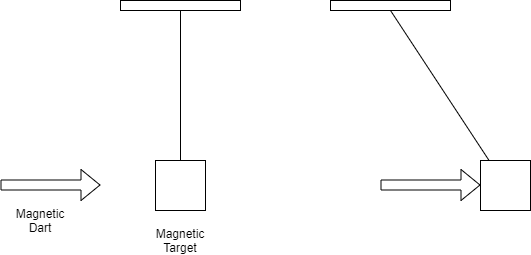All Solutions
Page 297: Practice Problems
$$
E_p+E_{kf}=E_k+E_{p0}
$$
Where $E_p$ and $E_{kf}$ are potential and kinetic energy at the final, highest point and $E_k$ and $E_{p0}$ are kinetic and potential energy at the lowest point:
Since we know that:
$$
E_{kf}=E_{p0}=0
$$
We can get:
$$
E_p=E_k
$$
$$
E_p=mgh
$$
And kinetic energy as:
$$
E_k=0.5cdot mv^2
$$
we can combine the three equations and get:
$$
0.5cdot mv^2=mgh
$$
We can cancel out $m$ on both sides and get
$$
0.5cdot v^2=gh
$$
$$
h=frac{v^2}{2g}
$$
Inserting values we get:
$$
h=frac{8.5^2}{2cdot 9.8}
$$
$$
boxed{h=3.69,,rm{m}}
$$
h=3.69,,rm{m}
$$
$KE_i = (1/2) m v^2$
$KE_i = (1/2) * (85.0) * (8.5)^2$
$KE_i = 3070 J$
Conservation of energy:
$KE_i + PE_i = KE_f + PE_f$
$3070 + 0.00 = 0.00 + PE_f$
$3070 + 0.00 = 0.00 + m g h$
$3070 = m g h$
$$
==> h = dfrac{3070}{m g} = dfrac{3070}{(85.0)*(9.80)} = 3.7 m
$$
In this particular case, the energy needed for the climb will be provided from the body of the rider, meaning it will transform from $textbf{chemichal energy}$ found in the food sources into $textbf{mechanical energy }$needed to propell the bicycle uphill.
When need to determine its velocity at the bottom of the valley floor, speed at the top of the next hill and determine whether or not angles affect the results.
The hills are frictionless.
$$
E_{kv}=E_{p1}
$$
$$
mgh_1=0.5cdot mv_v^2
$$
We can cancel out $m$ on both sides:
$$
gh_1=0.5cdot v_v^2
$$
From this we can get speed at the bottom of the valley:
$$
v_v=sqrt{2cdot g cdot h_1}
$$
Inserting values we get:
$$
v_v=sqrt{2cdot 9.8cdot 45}
$$
$$
boxed{v_v=29.7,,rm{m/s}}
$$
$$
mgcdot (h_1-h_2)=0.5cdot mv_2^2
$$
We can cancel out $m$ on both sides:
$$
gcdot (h_1-h_2)=0.5cdot v_2^2
$$
From this we can get speed at the bottom of the valley:
$$
v_2=sqrt{2cdot g cdot (h_1-h_2)}
$$
Inserting values we get:
$$
v_2=sqrt{2cdot 9.8cdot (45-40)}
$$
$$
boxed{v_2=9.9,,rm{m/s}}
$$
v_v=29.7,,rm{m/s}
$$
$$
v_2=9.9,,rm{m/s}
$$
Angles don’t affect result.
$(1/2) m v^2 = m g h_1$
$==> v = sqrt{2 g h_1} = sqrt{(2)*(9.80)*(45.0)} = 29.7 m/s$
the skier’s speed at the top of the next hill:
$(1/2) m v^2 = m g (h_1 – h_2)$
$==> v = sqrt{2 g (h_1 – h_2)} = sqrt{(2)*(9.80)*(45.0 – 40.0)} = 9.90 m/s$
the angles of the hills does not affect the answers.
textbf{Given:} \
$m_1 = 136 text{kg}$ \
$m_2 = 102 text{kg}$ \
$h_1 = 3.00 text{m}$ \
$g = 9.8 frac{text{m}}{text{s}^2}$\
noindent
textbf{Calculation:} \
For the second diver to have a competetive splash, his potential energy should at least be equal to the potential energy of the first diver
$$
PE_1 = PE_2
$$
$$
m_1gh_1 = m_2gh_2
$$
$$
h_2 = frac{m_1gh_1}{m_2g}
$$
Plugging in the given values
$$
h_2 = frac{(136)(9.8)(3.00)}{(102)(9.8)}
$$
$$
h_2 = 4.00 text{m}
$$
noindent
However, since the diving board is already $3.00 text{m}$ high, the second diver only need to leap by boxed{$1.00 text{m}$} high
1.00 text{m}
$$
$$
mv_{1i}+m_bv_{2i}=mv_2+m_bv_2
$$
From this we can get:
$$
v_{1i}=frac{(m+m_b)cdot v_2-m_bcdot v_{2i}}{m}
$$
Inserting values we get:
$$
v_{1i}=frac{(0.008+9)cdot 0.1-9cdot 0}{0.008}
$$
Finally we get:
$$
boxed{v_{1i}=113,,rm{m/s}}
$$
v_{1i}=113,,rm{m/s}
$$
$v_{1i} = ?$
$m_2 = 9.00 kg$
$v_{2i} = 0.00$
$v_{1f} = v_{2f} = v_f = 0.100 m/s$
Conservation of momentum:
$m_1 v_{1i} + m_2 v_{12} = m_1 v_{1f} + m_2 v_{2f}$
$(0.008) (v_{1i}) + (9.00) (0.00) = (0.008) (0.100) + (9.00) (0.100)$
Solve for $v_{1i}$:
$v_{1i} = dfrac{(0.08) (0.100) + (9.00) (0.100)}{0.008}$
$$
v_{1i} = 113 m/s
$$
113 m/s
$$
(a)\
The system that we will use is the magnetic dart and the magnetic target attached to a string. We will use the initial height of the magnetic target as our reference height.\

(b)\
The mechanical energy of the system is conserved because there are no external forces acting on the system.\
noindent
(c)\
textbf{Given: }\
$m_text{dart} = 0.025 text{kg}$ \
$m_text{target} = 0.73 text{kg}$ \
$h = 0.012 text{m}$
$g = 9.8 frac{text{m}}{text{s}^2}$\
noindent
textbf{Calculation:}\
Since the mechanical energy of the system is conserved, we can express it as follows
$$
ME_text{initial} = ME_text{final}
$$
$$
KE_text{initial} + PE_text{initial} = KE_text{final} + PE_text{final}
$$
$$
frac{1}{2}m_text{dart}v_i^2 + 0 = 0 + (m_text{dart} + m_text{target})gh
$$
noindent
Plugging in the given values
$$
v_i = sqrt{frac{2(m_text{dart} + m_text{target})gh}{m_text{dart}}}
$$
$$
v_i = sqrt{frac{2(0.025 + 0.73)(9.8)(0.12)}{0.025}}
$$
$$
boxed{v_i = 8.43 frac{text{m}}{text{s}}}
$$
(b) The mechanical energy of the system is conserved because there are no external forces acting on the system.
(c) $v_i = 8.43 frac{text{m}}{text{s}}$
$$
E_{ki}=0.5cdot mv_{1i}^2 + mv_{2i}^2
$$
Inserting values we get.
$$
E_{ki}=0.5cdot 91cdot 5.5^2+0.5cdot 91cdot 8.1^2
$$
$$
boxed{E_{ki}=4360,,rm{J}}
$$
$$
p_i=mv_{1i}+mv_{2i}
$$
Inserting values we get:
$$
p_i=91cdot 5.5 + 91cdot 8.1
$$
$$
boxed{p_i=1240,,rm{kgm/s}}
$$
$$
p_i=p_f
$$
And equation that connects momenntum after collision and velocity of the players:
$$
p_f=2cdot mv_f
$$
From these equations we can get their velocity:
$$
v_f=frac{p_i}{2cdot m}
$$
Inserting values we get.
$$
v_f=frac{1240}{2cdot 91}
$$
$$
boxed{v_f=6.8,,rm{m/s}}
$$
$$
Delta E_k=E_{ki}-E_{kf}
$$
$$
Delta E_k=E_{ki}-0.5cdot (2cdot m)cdot v_f^2
$$
inserting values we get:
$$
Delta E_k=4360 – 0.5cdot (2cdot 91)cdot 6.8^2
$$
$$
boxed{Delta E_k=150,,rm{J}}
$$
p_i=1240,,rm{kgm/s}
$$
$$
E_{ki}=4360,,rm{J}
$$
$$
v_f=6.8,,rm{m/s}
$$
$$
Delta E_k=150,,rm{J}
$$
the initial energy:
$K_i = (1/2) m_1 v_{1i}^2 + (1/2) m_2 v_{2i}^2 = (1/2)*(91.0)*(5.50)^2 + (1/2)*(91.0)*(8.1)^2 = 4360 J$
the initial momentum:
$p_i = m_1 v_{1i} + m_2 v_{2i} = (91.0)*(5.50) + (91.0)*(8.1) = 1240 Kg.m/s$
b)
$p_f = p_i$
$(m_1 + m_2) v_f = 1240$
$(91.0 + 91.0) v_f = 1240$
$v_f = 6.80 m/s$
c)
the final energy is:
$K_f = (1/2) m_1 v_{f}^2 + (1/2) m_2 v_{v}^2 = (1/2)*(91.0)*(6.80)^2 + (1/2)*(91.0)*(6.80)^2 = 4210 J$
$$
Delta K = K_f – K_i = 4210 – 4360 = -150 J
$$
b) $6.80 m/s$
c) $-150 J$

